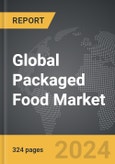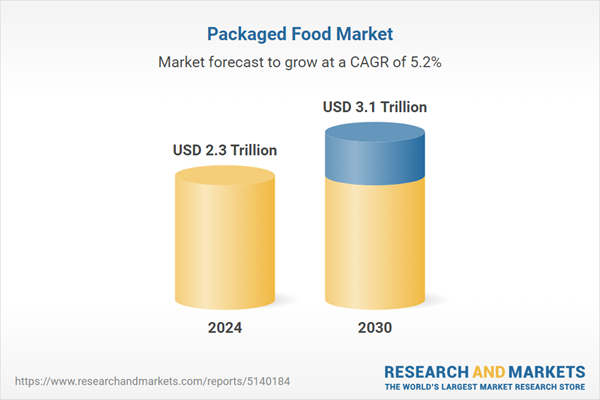The global market for Packaged Food was valued at US$2.3 Trillion in 2024 and is projected to reach US$3.1 Trillion by 2030, growing at a CAGR of 5.2% from 2024 to 2030. This comprehensive report provides an in-depth analysis of market trends, drivers, and forecasts, helping you make informed business decisions. The report includes the most recent global tariff developments and how they impact the Packaged Food market.
Segments: Type (Meat, Poultry & Seafood, Bakery & Snacks, Confectionery, Dairy Products, Ready Meals, Other Types); Distribution Channel (Supermarket / Hypermarket, Online, Grocery Stores, Specialty Stores, Other Distribution Channels).
Geographic Regions/Countries: World; United States; Canada; Japan; China; Europe (France; Germany; Italy; United Kingdom; Spain; Russia; and Rest of Europe); Asia-Pacific (Australia; India; South Korea; and Rest of Asia-Pacific); Latin America (Argentina; Brazil; Mexico; and Rest of Latin America); Middle East (Iran; Israel; Saudi Arabia; United Arab Emirates; and Rest of Middle East); and Africa.
The analysts continuously track trade developments worldwide, drawing insights from leading global economists and over 200 industry and policy institutions, including think tanks, trade organizations, and national economic advisory bodies. This intelligence is integrated into forecasting models to provide timely, data-driven analysis of emerging risks and opportunities.
Global Packaged Food Market - Key Trends & Drivers Summarized
Why Is the Packaged Food Market Experiencing Rapid Growth?
The global packaged food market, which includes a wide array of processed and pre-prepared foods that are sold in convenient, ready-to-use formats, is experiencing rapid expansion due to several factors. Changing consumer lifestyles, particularly the growing demand for convenience and time-saving meal solutions, have made packaged foods a staple in many households worldwide. With the rise of dual-income families, urbanization, and busier work schedules, consumers are increasingly opting for ready-to-eat or easy-to-prepare food options, driving demand across various segments of packaged food, from snacks and beverages to frozen meals and pantry staples. Packaged food products have also benefitted from innovations in food preservation and packaging, ensuring longer shelf life, enhanced safety, and improved product quality. As global markets continue to develop, packaged food remains an integral part of modern living, offering consumers both convenience and access to a wide variety of international cuisines.How Are Shifting Consumer Preferences Impacting the Market?
Consumer preferences are increasingly shifting toward health-conscious, organic, and clean-label packaged foods. As consumers become more aware of the health implications of their diet, they are demanding transparency from manufacturers regarding ingredients and sourcing. This has led to a surge in the popularity of packaged food products that emphasize natural, minimally processed ingredients and eliminate artificial additives or preservatives. In response to these preferences, manufacturers are producing organic, gluten-free, vegan, and non-GMO packaged foods, aligning with the dietary restrictions and ethical considerations of modern consumers. Furthermore, the rise of plant-based and alternative protein products has driven growth in the packaged food market, as more consumers seek sustainable and ethical food sources. The shift toward healthier lifestyles, combined with the desire for convenience, has opened new avenues for innovation and expansion within the packaged food industry.What Role Do Technology and Innovation Play in Packaged Food Growth?
Technology and innovation have been central to the growth of the packaged food market, particularly in terms of product development, packaging, and distribution. Advances in food processing technologies, such as freeze-drying, vacuum sealing, and aseptic packaging, have enabled manufacturers to offer products that retain their nutritional value while extending shelf life. This has made packaged foods more appealing to consumers seeking both convenience and quality. Innovations in packaging, including eco-friendly materials and portion-controlled options, have catered to environmentally conscious consumers while providing added convenience. Additionally, the rise of smart packaging, which includes features like freshness indicators and QR codes for product information, is improving consumer trust and satisfaction. In terms of distribution, the rise of e-commerce and direct-to-consumer delivery platforms has revolutionized the availability of packaged food, making it easier for consumers to access a wide range of products globally, thus fueling market growth.What Is Driving Growth in the Packaged Food Market?
The growth in the packaged food market is driven by several factors. The shift toward convenience and ready-to-eat products has significantly increased demand, particularly in urban areas where consumers have less time for meal preparation. Technological advancements in food preservation, packaging, and production processes have enabled manufacturers to maintain product quality and extend shelf life, further enhancing the appeal of packaged foods. The rise of e-commerce and the proliferation of online grocery platforms have improved the accessibility and availability of packaged foods, making them more convenient to purchase. Additionally, changing consumer preferences toward healthier, organic, and clean-label options have expanded the market for premium and specialty packaged foods. As manufacturers continue to innovate and cater to these evolving preferences, the packaged food market is expected to experience sustained growth, driven by increasing consumer demand for both convenience and quality.Report Scope
The report analyzes the Packaged Food market, presented in terms of units. The analysis covers the key segments and geographic regions outlined below.Segments: Type (Meat, Poultry & Seafood, Bakery & Snacks, Confectionery, Dairy Products, Ready Meals, Other Types); Distribution Channel (Supermarket / Hypermarket, Online, Grocery Stores, Specialty Stores, Other Distribution Channels).
Geographic Regions/Countries: World; United States; Canada; Japan; China; Europe (France; Germany; Italy; United Kingdom; Spain; Russia; and Rest of Europe); Asia-Pacific (Australia; India; South Korea; and Rest of Asia-Pacific); Latin America (Argentina; Brazil; Mexico; and Rest of Latin America); Middle East (Iran; Israel; Saudi Arabia; United Arab Emirates; and Rest of Middle East); and Africa.
Key Insights:
- Market Growth: Understand the significant growth trajectory of the Meat, Poultry & Seafood segment, which is expected to reach US$730.8 Billion by 2030 with a CAGR of a 5.4%. The Bakery & Snacks segment is also set to grow at 5.6% CAGR over the analysis period.
- Regional Analysis: Gain insights into the U.S. market, valued at $600.6 Billion in 2024, and China, forecasted to grow at an impressive 8.4% CAGR to reach $673.9 Billion by 2030. Discover growth trends in other key regions, including Japan, Canada, Germany, and the Asia-Pacific.
Why You Should Buy This Report:
- Detailed Market Analysis: Access a thorough analysis of the Global Packaged Food Market, covering all major geographic regions and market segments.
- Competitive Insights: Get an overview of the competitive landscape, including the market presence of major players across different geographies.
- Future Trends and Drivers: Understand the key trends and drivers shaping the future of the Global Packaged Food Market.
- Actionable Insights: Benefit from actionable insights that can help you identify new revenue opportunities and make strategic business decisions.
Key Questions Answered:
- How is the Global Packaged Food Market expected to evolve by 2030?
- What are the main drivers and restraints affecting the market?
- Which market segments will grow the most over the forecast period?
- How will market shares for different regions and segments change by 2030?
- Who are the leading players in the market, and what are their prospects?
Report Features:
- Comprehensive Market Data: Independent analysis of annual sales and market forecasts in US$ Million from 2024 to 2030.
- In-Depth Regional Analysis: Detailed insights into key markets, including the U.S., China, Japan, Canada, Europe, Asia-Pacific, Latin America, Middle East, and Africa.
- Company Profiles: Coverage of players such as Conagra Brands, Inc., General Mills, Inc., Hormel Foods Corporation, JBS SA, Kellogg Company and more.
- Complimentary Updates: Receive free report updates for one year to keep you informed of the latest market developments.
Some of the 43 companies featured in this Packaged Food market report include:
- Conagra Brands, Inc.
- General Mills, Inc.
- Hormel Foods Corporation
- JBS SA
- Kellogg Company
- Maple Leaf Foods, Inc.
- Nestle SA
- Smithfield Foods, Inc.
- The Kraft Heinz Company
- Tyson Foods, Inc.
Tariff Impact Analysis: Key Insights for 2025
Global tariff negotiations across 180+ countries are reshaping supply chains, costs, and competitiveness. This report reflects the latest developments as of April 2025 and incorporates forward-looking insights into the market outlook.The analysts continuously track trade developments worldwide, drawing insights from leading global economists and over 200 industry and policy institutions, including think tanks, trade organizations, and national economic advisory bodies. This intelligence is integrated into forecasting models to provide timely, data-driven analysis of emerging risks and opportunities.
What’s Included in This Edition:
- Tariff-adjusted market forecasts by region and segment
- Analysis of cost and supply chain implications by sourcing and trade exposure
- Strategic insights into geographic shifts
Buyers receive a free July 2025 update with:
- Finalized tariff impacts and new trade agreement effects
- Updated projections reflecting global sourcing and cost shifts
- Expanded country-specific coverage across the industry
Table of Contents
I. METHODOLOGYII. EXECUTIVE SUMMARY2. FOCUS ON SELECT PLAYERSIII. MARKET ANALYSISCANADAITALYSPAINRUSSIAREST OF EUROPESOUTH KOREAREST OF ASIA-PACIFICARGENTINABRAZILMEXICOREST OF LATIN AMERICAIRANISRAELSAUDI ARABIAUNITED ARAB EMIRATESREST OF MIDDLE EASTIV. COMPETITION
1. MARKET OVERVIEW
3. MARKET TRENDS & DRIVERS
4. GLOBAL MARKET PERSPECTIVE
UNITED STATES
JAPAN
CHINA
EUROPE
FRANCE
GERMANY
UNITED KINGDOM
ASIA-PACIFIC
AUSTRALIA
INDIA
LATIN AMERICA
MIDDLE EAST
AFRICA
Companies Mentioned (Partial List)
A selection of companies mentioned in this report includes, but is not limited to:
- Conagra Brands, Inc.
- General Mills, Inc.
- Hormel Foods Corporation
- JBS SA
- Kellogg Company
- Maple Leaf Foods, Inc.
- Nestle SA
- Smithfield Foods, Inc.
- The Kraft Heinz Company
- Tyson Foods, Inc.
Table Information
| Report Attribute | Details |
|---|---|
| No. of Pages | 324 |
| Published | April 2025 |
| Forecast Period | 2024 - 2030 |
| Estimated Market Value ( USD | $ 2.3 Trillion |
| Forecasted Market Value ( USD | $ 3.1 Trillion |
| Compound Annual Growth Rate | 5.2% |
| Regions Covered | Global |









